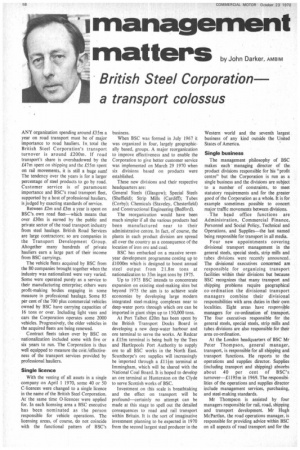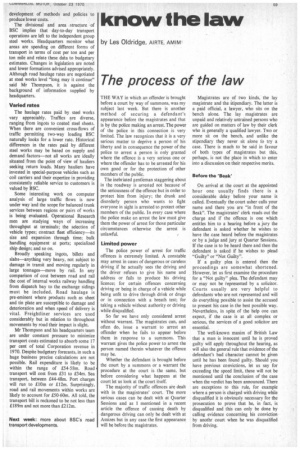management
Page 60

Page 61

If you've noticed an error in this article please click here to report it so we can fix it.
matters by John Darker AMB M
British Steel Corporation a transport colossus
ANY organization spending around £35m a year on road transport must be of major importance to road hauliers. In, total the British Steel Corporation's transport turnover is around £200m. If road transport's share is overshadowed by the £47m spent on shipping and the £55rn spent on rail movements, it is still a huge sum! The tendency over the years is for a larger percentage of steel products to go by road. Customer service is of paramount importance and BSC's road transport fleet, supported by a host of professional hauliers, is judged by exacting standards of service.
Between £2m and £3m a year is spent on BSC's own road fleet—which means that over £30m is earned by the public and private sector of the road transport industry from steel haulage. British Road Services are large contractors; so are companies in the Transport Development Group. Altogether many hundreds of private hauliers earn a large part of their income from BSC carryings.
The vehicle fleets acquired by BSC from the 80 companies brought together when the industry was nationalized were very varied. Some were operated purely as a service to their manufacturing enterprise; others were profit-making bodies engaging in some measure in professional haulage. Some 85 per cent of the 700 plus commercial vehicles owned by BSC have carrying capacities of 16 tons or over. Including light vans and cars the Corporation operates some 2000 vehicles. Progressively, the older vehicles in the acquired fleets are being renewed.
Contract fleets taken over by BSC on nationalization included some with five or six years to run. The Corporation is thus well equipped to measure the cost/effectiveness of the transport services provided by professional hauliers.
Single licence With the vesting of all assets in a single company on April 1 1970, some 40 or 50 C-licences were changed to a single licence in the name of the British Steel Corporation. At the same time 0-licences were applied for. In each licensing area a BSC executive has been nominated as the person responsible for vehicle operations. The licensing areas, of course, do not coincide with the functional pattern of BSC's business, When BSC was formed in July 1967 it was organized in four, largely geographically based, groups. A major reorganization to improve effectiveness and to enable the Corporation to give better customer service was implemented on March 29 1970 when six divisions based on products were established.
These new divisions and their respective headquarters are: General Steels (Glasgow); Special Steels (Sheffield); Strip Mills (Cardiff); Tubes (Corby); Chemicals (Staveley, Chesterfield) and Constructional Engineering (Bedford).
The reorganization would have been much simpler if all the various products had been manufactured near to their administrative centre. In fact, of course, the plants in each product division are spread all over the country as a consequence of the location of iron ore and coal.
BSC has embarked on a massive sevenyear development programme costing up to £1000m which is designed to boost annual steel output from 21.8m tons at nationalization to 33m ingot tons by 1975.
Up to 1975 BSC intends to concentrate expansion on existing steel-making sites but beyond 1975 the aim is to achieve scale economies by developing large modern integrated steel-making complexes near to deep-water ports through which ore can be imported in giant ships up to 150,000 tons.
At Port Talbot £20m has been spent by the British Transport Docks Board in developing a new deep-water harbour and ore terminal to serve the works. At Redcar a £115m terminal is being built by the Tees and Hardepools Port Authority to supply ore to all BSC works in the North East. Scunthorpe's ore supplies will increasingly be imported through a ft 1-im terminal at Immingham, which will be shared with the National Coal Board. It is hoped to develop an ore terminal at Hunterston on the Clyde to serve Scottish works of BSC.
Investment on this scale is breathtaking and the effect on transport will be profound—certainly no attempt can be made at this stage to spell out the detailed consequences to road and rail transport within Britain. It is the sort of imaginative investment planning to be expected in 1970 from the second largest steel producer in the Western world and the seventh largest business of any kind outside the United States of America.
Single business The management philosophy of BSC makes each • managing director of the product divisions responsible for his "profit centre" but the Corporation is run as a single business and the divisions are subject to a number of constraints, to meet statutory requirements and for the greater good of the Corporation as a whole. It is for example sometimes possible to concert major traffic movements between divisions.
The head office functions are Administration, Commercial Finance, Personnel and Social Policy, Technical and Operations, and Supplies—the last named being responsible for transport in all media.
Four new appointments covering divisional transport management in the general steels, special steels, strip mills and tubes divisions were recently announced. The divisional executives concerned are responsible for organizing transport facilities within their divisions but because BSC recognizes that many transport and shipping problems require geographical co-ordination the divisional transport managers combine their divisional responsibilities with area duties in their own localities. Eight areas have responsible managers for co-ordination of transport. The four executives responsible for the general steels, special steels, strip mills and tubes divisions are also responsible for their area co-ordination.
At the London headquarters of BSC Mr Peter Thompson, general manager, transport, is responsible for all shipping and transport functions. He reports to the operations and supplies director. Supplies (including transport and shipping) absorbs about 40 per cent of BSC's turnover—E1 195m in 1969. The responsibilities of the operations and supplies director ioclude management services, purchasing, and steel-making standards.
Mr Thompson is assisted by four managers responsible for rail, road, shipping and transport development. Mr Hugh McPartlan, the road operations manager, is responsible for providing advice within BSC on all aspects of road transport and for the development of methods and policies to produce lower costs.
The divisional and area structure of BSC implies that day-to-day transport operations are left to the independent group steel works. Headquarters monitor what areas are spending on different forms of transport in terms of cost per ton and per ton mile and relate these data to budgetary estimates. Changes in legislation are noted and lower formations advised appropriately. Although road haulage rates are negotiated at steel works level "long may it continue" said Mr Thompson, it is against the background of information supplied by headquarters.
Varied rates The haulage rates paid by steel works vary appreciably. Traffics are diverse, ranging from ingots to coated steel sheets. When there are convenient cross-flows of traffic permitting two-way loading BSC naturally looks for a lower rate. Historical differences in the rates paid by different steel works may be based on supply and demand factors—not all works are ideally situated from the point of view of hauliers seeking return loads. Many hauliers have invested in special-purpose vehicles such as coil carriers and their expertize in providing consistently reliable service to customers is valued by BSC.
Some interesting work on computer analysis of large traffic flows is now under way and the scope for balanced trunk services between regions or pairs of works is being evaluated. Operational Research men are studying ways of increasing throughput at terminals; the selection of vehicle types; contract fleet efficiency—its size and expansion through time; bulk handling equipment at ports; specialized ship design; and so on.
Broadly speaking ingots, billets and slabs—anything very heavy, not subject to damage in transit and moving regularly in large tonnages—move by rail. In any comparison of cost between road and rail the cost of internal works railway handling from dispatch bay to the exchange sidings must be included. Road haulage is pre-eminent where products such as sheet and tin plate are susceptible to damage and deterioration and when speed of delivery is vital. Freightliner services are used considerably but in relation to throughout movements by road their impact is slight.
Mr Thompson and his headquarters team are under constant pressure to minimize transport costs estimated to absorb some 17 per cent of total Corporation revenue in 1970. Despite budgetary forecasts, in such a huge business precise calculations are not possible. Rail expenditure is likely to be within the range of £54-58m. Road • transport will cost from £31 to £34m. Sea transport, between £44-48m. Port charges will run to £10m or £12m. Surprisingly, road and rail movements within works are likely to account for £50-60m. All told, the transport bill is reckoned to be not less than £189m and not more than £212m.
Next week: more about BSC's road transport developments.






































































































